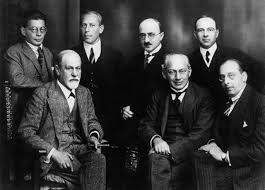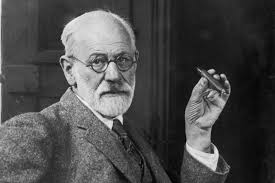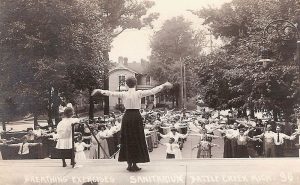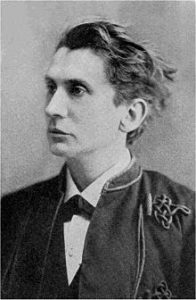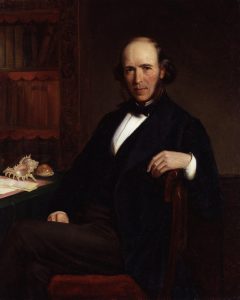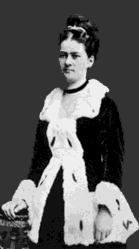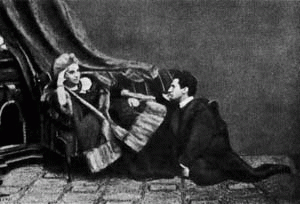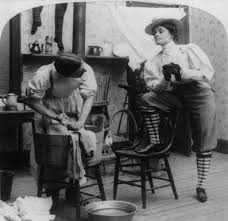
The First NYC AltSex Conference was held at the Jerry Orbach Theater in Midtown Manhattan on Friday April 20, 2016. It was the work of AASECT Certified Sex Therapist Michael Aaron, PhD and Dulcinea Pitagora, MA, LMSW. About 150 mental health professionals and kink and poly community members attended in person, and about a dozen participated electronically. Your intrepid reporter made the trip to the Big Apple to attend in person following favorable medical testing in Houston earlier that week. It was difficult to tell just how many professionals vs community members attended. Only one person attended in a business suit, looking like he had wandered in off of Wall Street. Embarrassing, really! However a number of prominent AASECT Members presented or were in attendance including Joe Winn, LICSW, CST-S, Lori Michaels, LMFT, CST, and AASECT AltSex Special Interest Group Chair, Kate Bornstein, Chris Farrington from the Community-Academic Consortium for Alternative Sexualities (CARAS), Carol Meeker from National Coalition for Sexual Freedom (NCSF), Sabitha Pillai, PhD, CST from Widener University with a group of her students, Jassy Timberlake, LMFT, CSSP, Director of Northampton Sex Therapy Associates, and other luminaries I missed in the rather dark venue. Sorry if I missed you!
This is, to my knowledge, the first professional event devoted entirely to Alt Sex Since AASECT’s 2006 Conference on BDSM put on by Richard Sprott in San Francisco. It was extremely encouraging to see that, in the age of social media, the event had been well publicized and was so well attended. Proceeds were donated to CARAS, and at the end of the meeting Chris announced a $1500 award for a research project investigating swinging, even as he disclosed that CARAS meetings were moving to a biannual schedule coordinated with the International Mister Leather event in Chicago. That means the meeting in San Francisco scheduled the day before the Folsom Street Fair this year has been cancelled.
I will proceed to provide brief summaries of the presentations. The event had no break outs, so we plowed through six presentations and a closing Q&A session together.
‘Kink is Good: Kink, Consensual Non-Monogamy and New Models of Sex and Gender Variance’ by Margie Nichols, PhD, DST.
 |
| Margie Nichols |
Margie began by challenging the historically pathology-based mental health model of kink and gender diversity. Citing queer historian Gayle Rubin, changes in the DSM, social constructionist social science, and queer theory, she argued for a ‘big tent’ conception of gender diversity, kink and relationship expression. She showed that the queer community had led the charge for greater acceptance of gender and sexual expression, and duly noted that there had been an historical tension between acceptance and exclusion of kink from the fight for sexual diversity, including the marginalization of Leathersex and SAMOIS. But she showed that new models proceed more from growing acceptance among the variant communities than from the tensions among them.
A strong aspect of her presentation included the lessons variant communities offer the therapist community in treating heterosexual and cis-gendered clients. These insights include nonjudgmental tolerance of sexual tastes, clear negotiation skills, emphasis on good technique, the power of sexual vulnerability to deepen intimacy and connection, sex as a direct expression of spirituality, the importance of honesty and good boundary setting, management of jealousy, the role of autonomy in effective relationships, and the non-sexual benefits of alternative relationships structures in social, community and child rearing activities.
Margie raised for me important questions in the fight against stigmatization. How important is it to be ‘out’? How are identity politics to be managed, and just how similar and different are people’s identifications? If all these communities can be seen as one, what unifies them besides the stigma they face from conventional society? Are alternative sexualities subcultures, or counter cultures? Since electronic communication has become so important, most communities are fragmenting. Her presentation effectively showed that identity had moved in the direction of greater variability and fluidity, and she emphasized the way marginalized communities had tended towards greater tolerance today than might have been the case decades earlier. Despite the history of this dance, therapists and others are in a better position to consume the insights of the AltSex communities in their work with all clients than they were twenty years ago. For Margie, the personal has always been political, and this is just as true for her today as when coming out was a much riskier leap of faith.
A special treat was seeing Margie get to present in front of one of her personal heroes, Kate Bornstein, who has lived out the fight for autonomy and diversity in her personal gender expression and served as a role model to many long before the Caitlin Jenner story became a riveting national discourse.
 |
| Margie Nichols and Kate Bornstein (photo probably by Barbara Carrellas) |
Myths and Realities of Consensual Non-Monogamy by Zhana Vrangalova, PhD.
 |
| Zhana Vrangalova |
Zhana began by defining monogamy and non-monogamy. Crucial in the studies she presents is how these concepts are operationalized as there is great tension in Western society between monogamy as ideology and as behavior. Taking the Center for Disease Control definition, sexual monogamy is “You agree to be sexually active with only one person and that person has agreed to be only active with you.” By that definition, a great many people avow monogamy, but by their forties, only about 10% of men and 20% of women have had only a single sexual partner. American infidelity rates range from 20% to 75% and only about 15% of 1230 societies in a cross-cultural database avow monogamy as their prevailing ideal marital style. As a social constructionist, I must warn that monogamy is very vague concept given its ideological prominence in Western culture.
Some of Zhana’s most compelling data showed the degree to which CNM was socially stigmatized. Across 22 variables, both conventionals and CNMists alike perceived CNM as inferior to monogamy on 20 of them. CNM was most disparaged for ‘preventing STI’s’ and ‘being morally superior.’, and was perceived as marginally better than monogamy only for ‘prevents boredom’ and ‘allows independence’.
Nevertheless, CNMists were more liberal. less religious, more educated, had higher incomes, endorsed less sexist, racist and heterosexist attitudes, less heterosexual, more open to new experience, and higher sensation seeking than the non-CNM comparison populations. She reported data from Fleckenstein and Cox showing that CNMs over 55 were physically healthier and happier than their conventional age mates in the General Social Survey sample, but were not mentally healthier.
Zhana also reported evidence from J Lehmiller that, contrary to conventional wisdom, consensual non-monogamy, as currently practiced, is not riskier for STI transmission than serial monogamy. This effect relies primarily on the data that suggest CNMists are a good deal more conscientious about condom use, that their pursuit of multiple simultaneous liaisons motivates them to use barrier protection longer, and that monogamists tend to cease using barrier protection when they decide the relationship is serious irrespective of the gestation times of STIs.
Bottom line, CNM relationships are actually riskier than monogamy only with respect to social stigma, not to sexual health, relationship quality, sexual satisfaction, or psychological well-being.
My chief question arising from this presentation was, what, if experienced CNMists and conventionals shared similar ideas about the inferiority of CNM, was needed to dispel the stigma? Apparently the presumption that monogamy is better is not based on experience, and is not dispelled by perceived success at CNM. In fact, the practicing CNMists do moderate their negative ratings of poly relationships somewhat on the basis of their actual experience.
Zhana closed her presentation with brand new research hot of the presses indicating that about 21% of people in two representative US samples (from the Kinsey Sexual Health and Behavior Survey) had had some form of CNM. The 21% figure was not correlated with typical predictors such as age, income, education, religion, political affiliation (all reported above!) but was higher for people who were male and those who were non-heterosexual in preference. (M Haupert et al, Indiana University, 2016).
The Kink-Poly Confluence: Community Intersections and Clinical Approaches by Dulcinea Pitagora and Michael Aaron
 |
| Dulcinea Pitagora |
Dulcinea began with some fairly standard definitions of BDSM and Poly. She then proceeded to explain the finding that about 40% of the kink community engages in CNM, about 40% of the CNM community does some kink. I would add that about 40% of the queer/gender fluid community does some kink too, but I am less clear how many kinksters are doing gender play. Partly this depends on how you identify gender play. But Dulcinea’s point is that certain shared ideologies promote interpenetration of these communities. Examples of her shared ideologies include:
Transparency
Communication
Negotiation/renegotiation
Consent
Cultivating connection
Challenging social norms
Personal growth
Interpenetration of these communities on FetLife, and shared experiences with social stigmatization also promote contact and shared values across these communities. A huge fly in the ointment in assessing just how much interpenetration there is hinges on how one defines the kink and poly communities. If one is speaking of out kinksters who attend public play parties, the nature of these events promotes open relationships because of play and demonstration ethics that prevail there. Shy, introverted, jealous, and exclusive people who do not have the values to be out are harder to identify in the community and in surveys. This is important when comparing how many people do kink from good representative studies like Ritchie et al, which found between 1.4 and 2.1 Percent of Australians were into BDSM, with results like Haupert et al that suggest around 1 in 5 have done some sort of kink and/or CNM.
I would also note that that list of shared ideologies overlaps kinksters with the therapist community despite the latter’s history of pathologizing kink and CNM!
And Dulcinea showed that shared adversities, such as pathologization, discrimination, fear of being outed, concealable stigmatized identities, and internalized stigma were held in common by kink and poly folk but are often not experienced by therapists who are not themselves kinky.
Dulcinea then debunked several myths about kink and poly, including that kink was primarily caused by childhood abuse experiences; that kink leads to out of control and escalating sensation-seeking and risk-taking behaviors; that poly folk were promiscuous – true for some but by no means all – and that, as Lehmiller’s work as cited by Zhana had shown, STI’s are not more common among the CNM communities as popularly assumed.
Dulcinea identified several common presenting complaints that are prevalent among kink and poly clients presenting for treatment: Problems with newbie identification and coming out to self, partners or others about emerging identity, relationship issues in the lifestyle context, and the typical array of mental health issues unrelated to identification or sex behaviors.
Finally, Dulcinea covered three clinical process issues commonly faced by therapists: Normalizing alternative sex behaviors and lifestyles; confronting transference and counter-transference issues related to alternative practices; and challenges of self-education, supervision and referral for clients that are outside a therapist’s cultural competence. And cultural competence remains a huge issue for the general community of therapists. In a survey by Kelsey in 2013, 76% of therapists responding had encountered at least one AltSex client and less than half had felt adequately informed about the topic. Dulcinea noted that there is a huge gap in training on alternative sexualities in mental health training generally, to which I would only add that this falls within the huge gap in sexuality training for the same fields. Kind of like a donut hole in the middle of a donut hole!
Facing Your Shadow: Psychological Edge Play by Michael Aaron
 |
| Michael Aaron |
Michael gave three reasons for edge play: exploration of the self, healing past hurts, and adrenaline rush. To explain those, he provided a brief history of what was meant by shadow, starting with the Marquis de Sade, and his influence on psychology through Freud and Jung. The latter two thinkers were united in their belief in the important role that the dark side of human psychology was crucial to understanding the function of the unconscious, but they divided over what the unconscious was. Freud though Jung’s view was dangerously social, and insufficiently idiosyncratic for each patient. Jung thought Freud’s view was too biological, and failed to account for the universals in inner experience. But however the unconscious was viewed, it involved our intolerance for negative emotions. Two of Michael’s quotes from Carl Jung are illustrative:
“Everyone carries a shadow, and the less it is embodied in an individual’s conscious life, the blacker and denser it is.” Psychology and Religion (1938)
“The shadow is the seat of creativity… represents the true spirit of life against the arid scholar.” Memories, Dreams and Reflections (1963)
With respect to the negative emotions of shadow, Michael presented the typology of Sylvan Tomkins [Affect Imagery (1962)] in which Tomkins reduced all negative emotions to combinations of shame and humiliation; distress and anguish; disgust; fear and terror; anger and rage; and dissmell (reactions to really bad smells). Michael argued that it was these unsettling feelings that could be brought to awareness with shadow or edge play.
To do so required the establishment of safety, boundaries and trust, which are embodied in the BDSM concepts of consent and negotiation. These established the conditions for constructive self-exploration.
With respect to healing past hurts, Michael began with the now familiar empirical evidence that BDSM interests are not caused by historical trauma, but went on to emphasize that that some people in the world of kink were quite deliberately healing trauma through BDSM activity. Michael presented theories of kink from Robert Stoller — Perversion: the Erotic form of Hatred (1975) and John Money — Lovemaps (1986) as examples of alternative theories of kink causation. (My quick summary: To grossly oversimplify, Stoller was a long time student of gender, and reframed Freudian theories of perversion into threats to the paraphilic’s gender identity. Money synthesized observations from ethology with Freudian ideas about the unconscious to explain how sexual preferences might be caused by preconscious interactions in early life.) Michael then used opponent process theory to explain how a kind of mastery over past hurts could be achieved through enactments in contemporary life.
Finally, with respect to adrenaline rush, Michael cited the theories of Jack Morin, — The Erotic Mind (1996) -who is noted for his insight that special erotic intensity attends sexual activities that are founded on obstacles to sexual expression based on negative emotions. Morin thought that some sex therapy properly focused on removing barriers like performance anxiety and inhibitions to achieve freer sexual expression. But erotic intensity could be enhanced by presenting and overcoming barriers that were in a Goldilocks zone of being formidable enough to overcome without being either trivial or overwhelming. Given the relationship between fear and adrenaline, Morin’s ideas seem tailor made for some kinky erotic expression. Other sources of intensity: longing and anticipation as in edging and orgasm denial; violating prohibitions through transgressive behaviors; the experience of power itself; and overcoming ambivalence.
One of the strengths of Michael’s presentation was that it overcomes the common problem of defining edge play in terms of some domain of specific activities. Implicit in this model is that what is on the edge for one person is not on the edge for another, and that the edge is necessarily time and context dependent. If real self-discovery is happening, the edge moves as one gains experiences. What is in shadow at one time comes into the light, and may later return to shadow. But notice that the healing and self-discovery models have different implications. If one is learning new things about oneself, the edge will move. New shadows are cast and discovered. If Jack Morin is correct, one returns to the same obstacles over and over because that is where the fear is and where the adrenaline rush can be generated in overcoming them. Play is likely to become ritualized. A fear that is overcome becomes old hat, and loses its adrenaline rush.
Metamorphosis: Braving Transitions in Polyamorous Relationships by Rosalyn Dischiavo EdD, MA CSES of the Institute for Sexuality Education (ISEE)
 |
| Roz Dischiavo |
Roz’s presentation is the first application of a model from family systems theory originally articulated by Papernow in 1993 for use with blended families, to the new application of helping polyamorous ‘families’ understand certain transitions in poly life and troublesome enough that they are very commonly encountered among poly clients who come to therapy.
Roz began with explanations of various transitions in polyamorous life, giving examples of a couple changing from swinging to poly lifestyle, or from couples-based poly to egalitarian poly, or the dread ‘replacement’ in which a poly couple dissolves and one of the partners is replaced by a metamour. But a common source of therapy referrals generated by couples is the transition from monogamous pairs to a poly family, and this is the work to which Papernow’s model is most closely analogous.
Paparenow’s model has seven stages:
Fantasy
Immersion
Awareness
Mobilization
Action
Contact
Resolution
In Fantasy, the participants each have their preconceived ideas and ideologies about how the blended family is going to work. In blended families, that may mean ideas by the biological parent about how great the step parent will be, or ideas and fears that the kids may have about how the step will try to replace their ‘real’ parent. In poly, this often means the love felt for the metamour and untested ideas about how the metamour will get along in relation to the newly poly couple. Often it does not include realities about how finances are going to be managed, space shared or chores divvied up. I would add that it is useful to note the similarities between Roz’s model here and the work of Esther Perel who identifies romantic idealization as a frequent obstacle to satisfying sexual relationships for many couples, not just kinky ones. Aspects of Roz’s model may often apply to the social context of resolving other intimacy concerns.
In Immersion, both in blended families and in poly, the illusions held when fantasies are untested tend to get shattered. The step parent proves far less invested, or perhaps over-invested in parenting. The metamour proves surprisingly intolerant of all the video gaming, hates Game of Thrones, didn’t realize how hard it is to live day-to-day with a gluten-free diet, or doesn’t want to leave and go back to his house at everyone’s bedtime. If nothing works, chaos or failure may ensue, but assuming the shattering is not too severe, the systems proceed to…
Awareness of the realistic problems that need to be overcome to accomplish the originally wished for goods that were articulated in fantasy. The participants confront the new realities that cause their fantasies to fail to work out as planned and struggle with the confusion about that tension between expectations and results.
Mobilization occurs when participants try to adjust to the new realities. Conflict is often high, negotiations are attempted, expectations are revised, sometimes brutally. Perhaps at this stage, the blended family fails and kids go to the other parent or the step partner returns to their own residence. In poly, perhaps the original couple abandons the attempt to transition. Often, new strategies are mutually arrived at, and go forward on a more realistic basis than was attempted during immersion.
Action synthesizes these new efforts with new, and often more broadly participatory agreements. The new relationship structures go forward on a more solid foundation. Participants start to have positive experiences with the transition where the adjustments have been successful.
Contact results from the accumulation of positive experiences at bonding, conflict resolution, and redefined roles that emerged in Mobilization and Action. If things weren’t fixed, the blend or transition may have failed, but usually successful Action results in increased trust and conflicts when they occur here are routine and managed, rather than scary, new and threatening to the new structure.
Resolution occurs when adjustments have stabilized to the new relationship structures. These may not all be positive, for example the teen who opposed step mom moving in and controlling everything is spending more time away from home at friends now and is less involved with the family, but everyone is accepting of the new order and coping strategies are in place for the routine rough spots it entails.
Papernow’s family systems approach looks at these steps in terms of their participants’ different fantasies, roles, expectations, and the resources and rules by which the resources are allocated to manage conflicts and transitions. Different families have different contexts, histories and traditions, even if they more or less confront these steps. This model does not make the process of transition primarily dependent on explanations involving individual psychopathology, which is a huge advantage in terms of making therapy a place where stigma is not inadvertently perpetuated against nontraditional participants and their experiences.
I would add that in so far as coming out kinky or gay can also involve a process very much like this one, particularly for people who see their variant status not just as an intrapsychic issue of personal identity, but who require certain reactions from a larger social system in which they are embedded. We are not just mental health professionals, kinky, cancer patients, or church elders for ourselves, but in terms of their effects on others. So this model can be important when others are involved in decisions that are nevertheless primarily viewed as personal. But as a family systems model, it can only work with intimately involved participants. It might help when coming out to your partner or family of origin, but is going to be difficult to use with your employer, bowling league, or church group, even though their reactions are important to you.
A salient strength of Roz’s application of Papernow is that it provides an understandable context for the often disruptive feelings that accompany transitions. It normalizes anxieties, losses, and conflicts that are commonly encountered. It is terrific at destigmatizing the rough spots of transition, and this is particularly important for people who may already be gun shy because of the history of stigma CNMs and kinksters face in the general society. And the model itself is inherently destigmatizing for a general audience by making clear that it many ways, for all their colorful and titillating differences, AltSex folk confront understandable conflicts with which we are all familiar. Men aren’t from Mars, women from Venus, trans folk from the asteroid belt and kinksters from Uranus (sorry, couldn’t resist!). We are all from earth, and subject to many of the same influences despite our differences.
Age Play: Eros, Practicality, and Walking the Edge by David Ortmann, LCSW
 |
| David Ortmann |
Perhaps the bravest presentation was David’s exposition of how age play might be a creative outlet for the sexual expression of pedophilic desires. While this is a common sense idea, it flies in the face of a great deal of political theory that suggests that consensual AltSex groups stay away from any content as socially poisonous as an analogy between adult kinky activity and pedophilia.
Age play is a form of erotic role play in which participants take roles that emphasize differences from their chronological age. Often this has a strongly regressive component and adults assume the roles of teens, children, toddlers and infants. When one partner is the adult, they are the ‘big’, and the partner who plays a child is the ‘little’. A certain amount of this goes on in non-kinky relationships when we call our partner ‘baby’ or ‘daddy’. In age play, partners may assume caretaking functions that are far removed from adult/adult activities such as diapering, toilette training, spanking and discipline, feeding, suckling, and just about anything that turns them on. As age and childhood status are heavily saturated with power dynamics, there is plenty of opportunity for age related D/s, and enactment of incestuous and seductive dynamics.
Given these issues, the kink community has made strenuous efforts to differentiate age play from attraction to under age people as sexual objects. That boundary rests on several ideas. First, kinks is stigmatized enough as it is, and kinksters do not wish to blur the public perceptions about who is in their communities. Second, consent is fundamental to kink community ideology, so discussion of any activity that does not involve fully consenting adults is anathema. Third, pedophiles, as arguably the most stigmatized sexual variation of them all, do not exactly make safe political bedfellows. And perhaps most important of all, the science about the relationship between sex desire and behavior is so poor, we have no idea how many people with pedophilic desire refrain from ever committing illegal behaviors despite those desires. Such people are powerfully disincentivized to come forward and admit to desires that are, in some legal venues, illegal to even articulate. There are some states that require therapists to report client disclosures of any contact with child porn, and these laws are always intended to make state officials, rather than the therapist community, responsible for deciding what the boundaries are to tolerated personal expression.
So David’s suggestion that age play might be a safe outlet for people with pedophilic desires is not easy to listen to for kinksters, the mental health community, or the larger society which, despite solid scientific evidence to the contrary, is so afraid of sexual differences that they expect transgendered people to assault them in public restrooms. At this point I would also remind the reader of Margie’s history, in which female sadomasochists were excluded by mainstream feminists, lesbians initially excluded from the Leathersex community, and kinky folk generally marginalized by conventional society despite Kinsey’s evidence that sexual variability is typical. If the treatment of pedophiles who don’t offend is left to forensic psychologists, what chance do non-offending people have of getting the healing power of social connections and the opportunity to tell their stories in a context where they might expect a sympathetic hearing?
David’s argument is a rational one. If otherwise cis-gendered or gay kinksters can get sexual satisfaction from playing at being bigs and littles, why shouldn’t some pedophiles be able to sublimate their desires into legally unobjectionable role play with adults assuming the roles of children?
In the present environment, scarcely any group is motivated to appropriate money to make an investigation of so-called ‘virtuous’ (non-offending) pedophiles. Present practice is to attempt to force the label pedophile on anyone who admits to such desires. What we do know about pedophiles is almost entirely through the study of people who have been criminally prosecuted. The US vigorously prosecutes child porn, even when it is kept on foreign servers in jurisdictions that do not criminalize these behaviors or do not share any of our varying State laws about the age of consent.
David presented his conclusions from 12 cases that fantasy could be used constructively to manage pedophilic impulses, and reported only one case where serious problems were encountered with such work. It is certainly true that a great deal of shadow play goes on in the kink community, much of it benign or constructive, but problems are occasionally reported. But as data goes, this is folk wisdom, not yet science.
We have heard from others at NYC AltSex 2016 that there is insight to be had by moving toward our fears. David has done a great job of modeling exactly that.
Miscellanea:
 |
| The afterparty: left-to-right: Lydia Leinsdorf, Dulcinea Pitagora, Michael Aaron, attendee, Zhana Vrangalova, and Russell Stambaugh |
The conference included a Q&A with all the presenters, which I will decline to summarize, and a social gathering in a Lower East Side watering hole attended by the conference organizers, volunteers, and a few of the attendees. All-in-all, it was a very well put together event. Perhaps the organizers will brag here about how much money was raised for CARAS.
A sure sign of success is that the event will be repeated in NYC AltSex 2017 scheduled for April 28, 2017. Congratulations to everyone who made it so successful!
Credits: While the work of the presenters is their own, the summaries and some commentary are the responsibility of the blog author. I am solely responsible for any errors, and will cheerfully correct them.
All presentations had slides except David’s. Requests for slides or references are for the presenters, please.
Photos here, except as noted, are submissions from the presenters and stolen by the author. The afterparty photo is the work of the NYC AltSex 2016 Conference photographer.
Within all those caveats:
© Russell J Stambaugh, May, 2016, Ann Arbor MI, All rights reserved























